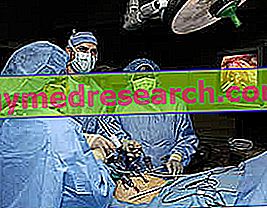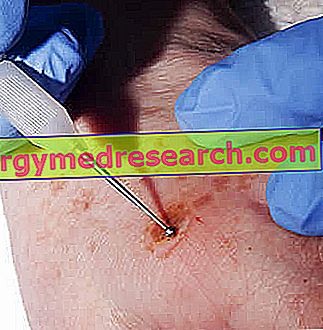Generality
Laparoscopy is a modern surgical technique, which allows the operating physician to diagnose and / or treat problems and pathologies, at the level of the abdominal cavity or of the pelvic cavity, without performing extensive surgical incisions.

Laparoscopy operation
The most representative instrument of laparoscopy is the laparoscope; it is a thin tube (5-10mm in diameter) which, once introduced into the abdomen or pelvis of a patient, allows to see the appearance of the internal organs thanks to a lighting system and a small fiber optic camera .
Although the incisions made to introduce the surgical instrumentation are very small (approximately 1 cm each), laparoscopy requires general anesthesia.
The results are more than satisfactory, since, compared to traditional surgery, post-operative recovery is very fast and the risks of complications are very low.
What is laparoscopy?
Laparoscopy (or Video-Laparo-Surgery - VLC ) is a minimally invasive surgical technique, thanks to which the operating doctor can access the abdominal cavity and the pelvic cavity of a patient, without resorting to the large incisions required by traditional open surgery .
In fact, laparoscopy involves the creation of a small number of small incisions, necessary to introduce a particular instrument, the laparoscope, and any other surgical tools.
WHAT IS LAPAROSCOPE?
The laparoscope is the main and most representative instrument of laparoscopy.

Figure: a laparoscope. From the site: chinamedevice.com
Similar to a drinking straw, at the end to be inserted inside the organism it presents a network of optical fibers, which act as both a light source and a camera . All that is illuminated and taken up by the laparoscope is projected in real time on a monitor, so that the surgeon can orientate himself inside the abdomen (or pelvis) and perform the operation correctly.
ADVANTAGES OF LAPAROSCOPY
Compared to "open" surgery, the reduced invasiveness of laparoscopy provides several advantages:
- Shorter hospitalization (usually only one night) and faster healing
- Less pain and less blood loss after the operation
- Less obvious scars
WHAT KIND OF ANESTHESIA DOES IT PROVIDE?
Although this is a minimally invasive method, laparoscopy requires general anesthesia . Therefore, the patient will be sedated and rendered completely unconscious for the duration of the intervention.
When you run
Laparoscopy can serve both diagnostic and therapeutic purposes. Depending on the purpose, the number of incisions and the instrumentation used may vary (NB: in the therapeutic laparoscopy, in addition to the laparoscope, other surgical instruments are also used), but the basic principle, or act in the least invasive way possible, and the preparation remain unchanged.
DIAGNOSTIC LAPAROSCOPY
Usually, in the diagnostic field, non-invasive procedures are preferred, such as nuclear magnetic resonance (NMR) and / or ultrasound. However, it may happen that these harmless patient procedures provide unclear or complete results. In such situations, therefore, it is possible that the doctor is forced to resort to surgery.
Diagnostic laparoscopy is adopted only in extreme cases, since, despite being minimally invasive, it is still a surgical procedure; in fact it requires anesthesia, skin incision, a special preparation, a post-operative phase and so on.
Thanks to diagnostic laparoscopy it is possible to identify the following conditions:
- Pelvic inflammatory disease . It is an inflammatory process, acute or chronic, which affects the reproductive organs of the woman and the adjacent structures. It may be due to various infectious agents present in the female genital area, including Chlamydia trachomatis, Mycoplasma hominis and Neisseria gonorrhoeae .
- Endometriosis . It is a disease characterized by the presence of endometrial tissue outside its natural site, ie the uterus.
- Ectopic pregnancy . It is the medical term for a pregnancy that occurs outside the uterus (extrauterine ectopic pregnancy) or in an inadequate location of the uterus (intrauterine ectopic pregnancy).
- Ovarian cyst . It is a small bag full of liquid that forms inside or on the surface of the ovaries.
- Uterine fibroma . It is a benign tumor that forms inside or on the surface of the uterus
- Female infertility .
- Cryptorchidism . It is the medical term that indicates the failure of one or both testicles to descend from the abdominal cavity to the scrotum.
- Appendicitis . It is the inflammation of a small section of large intestine, called an appendix.
- Abdominal and / or pelvic pain for no apparent reason .
- Malignant tumors of the abdominal / pelvic organs . The possible organs affected are: liver, pancreas, kidneys, ovaries, bile duct and gall bladder.
Diagnostic laparoscopy and tumors
In the case of cancer, diagnostic laparoscopy offers the possibility of taking, from the diseased organ, a small sample of cells to be subsequently analyzed in the laboratory (biopsy).
If the surgeon finds a problem that can (or should) be resolved immediately, the diagnostic laparoscopy can become, during the same session, also therapeutic.
THERAPEUTIC LAPAROSCOPY
Using laparoscopy, the surgeon can perform various surgical procedures, such as:
- Remove the inflamed appendix.
- Remove the gallbladder ( cholecystectomy ), if it is affected by gallstones.
- Remove a strongly inflamed section of intestine that does not improve with any kind of less invasive treatment. This happens, for example, in the case of Crohn's disease or diverticulitis .
- Make a hernial plastic. A classic example is the intervention of inguinal hernia .
- Stop bleeding caused by a gastric ulcer .
- Remove portions of adipose tissue to reduce an individual's body weight.
- Remove an organ, or parts of it, affected by a malignant tumor
- Remove the embryo from a pregnant woman with an ectopic pregnancy.
- Remove one or more uterine fibroids.
- Removes the uterus ( hysterectomy ), in cases of pelvic inflammatory disease, endometriosis, etc.
Preparation
A few days before laparoscopy, the patient is required to go to the clinic, where the operation will take place, to undergo a series of cognitive clinical checks and to be informed of everything that the procedure entails (from the intervention procedures to the recommendations pre- and post-operative).
The preparation required for a diagnostic laparoscopy is the same as for a therapeutic laparoscopy.
KNOWLEDGE CLINICAL EXAMINATIONS
The cognitive clinical checks are necessary for the physician to determine whether the patient can undergo laparoscopy safely. Specifically, these exams consist of:
- A thorough physical examination
- An evaluation of clinical history (diseases suffered in the past, possible allergies to anesthetic drugs, medicines taken at the time of checks, etc.)
- A complete blood test
- An electrocardiogram
In fact, it is the classic controls that are carried out before any surgical operation in which anesthesia is also provided (it does not matter, whether local or general).
INFORMATION ON INTERVENTION MODES
Once the cognitive clinical checks have been completed, the patient is informed of what the operation involves, what is the duration of the entire procedure, what anesthesia is provided and how long the healing phase usually lasts (NB: except for anesthesia, which is always of a general type, the other parameters also vary according to the causes for which laparoscopy is required).
It is at this time that the patient is invited by the medical staff or by the surgeon himself to remove any doubt or fear regarding the operation.
PRE- AND POST-OPERATIVE RECOMMENDATIONS
For the whole operation to proceed smoothly, the patient is obliged to:
- Before laparoscopy, suspend any pharmacological intake based on antiplatelet agents (aspirin), anticoagulants (warfarin) and anti-inflammatory drugs (NSAIDs); these drugs, in fact, reduce the coagulation capacity of the blood predisposing to serious blood loss.
- On the day of laparoscopy, appear at full fast from at least the previous evening, as general anesthesia is provided.
- After the surgery, be accompanied home by a family member or friend, because the patient will not be self-sufficient. Furthermore, driving a few hours after anesthesia is considered very dangerous.
Procedure
Once the patient has been anesthetized, the surgeon makes a small incision of about 1 centimeter on the abdomen, in correspondence of the navel. Then, through this opening, it introduces a small tube necessary to blow in carbon dioxide (which expands the abdomen allowing a better vision) and to conduct the laparoscope inside the abdominal / pelvic cavity (NB: for the operation of the laparoscope, face reference to what described at the beginning of the article).

Fig. representation of a therapeutic laparoscopy operation in this image taken from the site: gmchospital.com
At this point, if laparoscopy is therapeutic, the surgeon makes a second incision (similar in size to the first) and then introduces the surgical instruments necessary for treating the pathology or health problem in progress.
The site of the second incision depends on the type of operation and the location of the organ to be treated.
If you need it, the surgeon could make a third incision.
CONCLUSIVE PHASES OF THE OPERATION
In the terminal stages of laparoscopy, the surgeon removes the carbon dioxide blown into the abdominal cavity and pelvis, closes the incisions with stitches and applies a bandage on the wounds, to protect them from infection.
DURATION OF LAPAROSCOPY
The duration of the laparoscopy depends on the purpose of the procedure; the diagnostic one lasts between 30 and 60 minutes, while the therapeutic laparoscopy is the longer the more complicated the operation to be performed.
What is general anesthesia?
General anesthesia involves the use of anesthetics and painkillers, which render the patient unconscious and insensitive to pain.
The administration of these drugs, carried out intravenously and / or inhaled, occurs before and throughout the duration of the surgery.
At the end of the operation, the anesthesiologist (or a doctor specialized in anesthesia practices) stops the drug treatment, to allow the patient to regain consciousness.
A VARIANT WITH THE CLASSIC LAPAROSCOPY: ROBOTIC LAPAROSCOPY
Recently, experts working in the field of medical technologies have designed and made available to surgeons a robotic instrument, with which it is possible to perform even more precise and even less invasive laparoscopy operations.

Fig. equipment for robotic laparoscopy operations. From the site: orlandohealthdocs.com
This instrument, which responds to the commands of a special console, consists of an exploratory camera and a series of mechanical arms, which in effect replace the surgeon's hands.
Post-operative phase
As soon as laparoscopy is completed, it is likely that the patient will feel dazed and disoriented: this is a normal effect of general anesthesia, which can last from 12 to 24 hours.
Without complications, laparoscopy does not involve hospitalizations longer than one day; before discharge, however, the patient is carefully monitored by the medical staff, in order to see how he reacts to the operation.
At the time of discharge, the operating surgeon will communicate the date of the check-up (in which the stitches will also be removed) and the pain-relieving drugs to be taken in case of intense pain; pain is, in fact, another common sensation that the patient can feel.
Once at home, the operated individual must be careful to always keep the bandages clean, since, especially immediately after the operation, it is particularly fragile and at risk of infections.
what happens if carbon dioxide remains inside the abdomen?
The surgeon may not be able to completely empty the abdomen from carbon dioxide.
This could cause abdominal bloating, abdominal cramps and shoulder pain in the patient.
These symptoms must not worry, because they disappear, without any treatment, within a few days: carbon dioxide is, in fact, absorbed by the body and expelled with respiration.
HEALING TIMES
The healing time depends on:
- The purpose of laparoscopy
is
- The patient's health status
If the laparoscopy was only diagnostic, the return to normal activities can take place even after a week (NB: in these cases, much obviously depends on what the laparoscopic examination found).
If, on the other hand, laparoscopy has been therapeutic, recovery times vary according to the type and severity of the operation: for example, in the case of simple appendicitis, healing takes place in about 2 weeks, while, in case of ovarian cancer, may also occur after 12 weeks. Therefore, the more serious the pathology for which laparoscopy is required, the longer the post-operative phase will be.
IN THE PRESENCE OF WHICH DISTURBANCES MUST YOU CONTACT THE DOCTOR?
It is good that the patient contacts his doctor, if he warns:
- Fever above 38 ° C
- Chills
- Abdominal pain that, instead of easing, gets worse
- Redness, swelling pain and pus leakage at the wounds
- Pain and swelling on one of the two legs
- Burning and a sense of pain while urinating
risks
Thanks to advances in medical technologies, laparoscopic surgical procedures have now become a safe practice: the appearance of serious complications, in fact, is very rare.
According to Anglo-Saxon research, a maximum of two out of 100 patients undergo minor complications and only one patient out of 1000 runs into serious complications.
MINOR COMPLICATIONS
The minor complications are the risks that lie behind every surgery in which general anesthesia is expected. They consist of:
- Post-operative infections of surgical wounds.
- Repeated bleeding and appearance of hematomas around the incisions (NB: a hematoma is a collection of blood, which is concentrated in a cavity or in a tissue of the body).
- Sense of nausea and vomiting, due to general anesthesia.
SERIES COMPLICATIONS
The most serious complications that laparoscopy can involve are:
- Damage to an abdominal / pelvic organ (intestine, bladder etc.) with consequent loss of its functionality.
- Damage to one of the major arterial vessels (eg the descending aorta).
- Serious allergic reaction to the anesthetic used.
- Formation of blood clots inside the veins ( deep vein thrombosis ) and their transfer into the blood vessels leading to the heart ( pulmonary embolism ).
- Adverse reaction to the presence of carbon dioxide inside the abdomen.
- Formation of severe intra-abdominal adhesions (or adhesions) . Intra-abdominal adhesions are bands of fibrous tissue that are created as a result of the healing process, and that affect the normal anatomy of internal organs. In fact, they are internal scars located at the points where the surgeon intervened.
When such problems arise, it is very common for a laparoscopic surgery to be followed by a repairing surgery.



